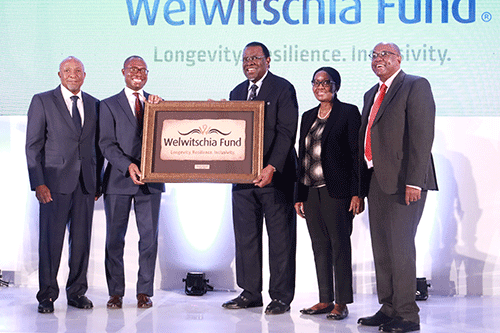In an effort for government to position itself to take advantage of anticipated economic tailwinds that could potentially propel Namibia towards renewed growth and opportunity, the country launched its first sovereign wealth fund, known as the Welwitschia Fund.
Government said the launch of the fund is a testament to its commitment to uplift the lives of Namibians and guarantee socio-economic progress.
The Welwitschia Fund is established for two objectives, namely saving for future generations, and fiscal and official reserve stabilisation.
The fund is envisaged to be a repository of the investment of a portion of defined proceeds from the present utilisation of natural resources and returns from divestiture in state assets. On the second objective, the fund aims to provide insulation to and stabilisation of the economy, the national budget and the country’s stock of international reserves against excess volatility in commodity prices and shocks on the fiscal accounts and the balance of payments.
Launching the fund yesterday, President Hage Geingob said a sovereign wealth fund can be a potent tool in achieving economic growth. Similarly, it can also act as an important fallback and stabiliser during times of extreme shocks.
Since 2016, Namibia has faced tough economic times with a decline in commodity prices, devastating droughts and recently the emergence of the Covid-19 pandemic, which Namibia is still reeling from.
Geingob affirmed that there will be operational independence in the fund to make sure it serves its purpose. “Ownership of the fund is vested in the Namibian government, while the Bank of Namibia will be the fund’s primary custodian, responsible for its administrative function”.
The President said the country is now progressing beyond maintaining only foreign exchange reserves for meeting international payment obligations. With enough international liquidity in hand in the country’s reserves, Namibia can now expand its official asset holdings to investments that are less liquid but yielding higher returns over the long run.
Furthermore, Geingob said the Welwitschia Fund will commence with money estimated around N$262 million.
“The road that led to today was not an easy one. In fact, it took endless hours of research and the necessary groundwork, as narrated by the Minister of Finance. The work started in earnest with the appointment in March 2019 of the High-Level Panel on the Namibian Economy and its impactful recommendations.
“Namibia is a country with a rich natural resources endowment, both minerals and other non-renewables, as well as diverse wealth in fauna and flora. These resources all contribute significantly to the development of the Namibian economy. Since independence, the successive administrations have used Namibia’s non-renewable resources to the benefit of its people through the provision of essential services, and the dividend has been evident in socio-economic outcomes such as the reduction of poverty and inequality, provision of affordable housing, education and healthcare services, amongst others.”
The funding sources for the sovereign wealth fund, he stated, comprises a combination of streams, including a portion of royalties collected from the sales of natural, renewable and non-renewable mineral resources, taxes, divestiture from public investment holdings as well as contributions from identified state-owned enterprises and other parties.
The President added that government is looking forward to the prospects and opportunities that will emanate from the recent discoveries of oil and the green hydrogen energy, which have the potential to further boost the fund’s capital and ultimately contribute to the development of the Namibian economy.
Geingob said the fund’s mission and mandate must be clearly defined in legislation from the outset, with distinct lines of accountability and independent oversight to avoid deviation and the misuse of resources at a later stage. This sets the parameters for the operation and risk appetite of the investment function, while aligning it with its policy objective. In turn, the investment function requires processes and systems that guarantee independence from direct and undue external influences.
The President further suggested that the governing board needs to be composed of independent directors, based on their experience and area-specific expertise. For this reason, the process of establishing the fund was informed by vigorous research and consultation with domestic, regional and international stakeholders to ensure that we have a fund that has clearly set objectives, supported by the necessary regulatory and institutional frameworks.
At the launch, Bank of Namibia governor Johannes !Gawaxab said the creation of the Welwitschia Fund will, without doubt, strengthen Namibia’s fiscal stability and resilience to the external shocks that stem from Namibia’s interconnectedness with the global economy.
“Sovereign wealth funds have shown that they can play a shock-absorbing role in global financial markets by dampening short-term market volatility, and financially aiding countries in times of crises. They stabilise both fiscal outcomes and the balance of payments. The Welwitschia Fund will facilitate the transfer of wealth sourced from Namibia’s abundant natural resources so that generations to come also benefit, even long after the current resource base is depleted,” he stated. !Gawaxab said the Welwitschia Fund will comprise two independent investment accounts or portfolios, namely the stabilisation account and the intergenerational savings account. Each of these portfolios will have different risk and return characteristics, commensurate with their investment objectives and constraints.
The stabilisation account will be invested in offshore fixed income assets with a focus on low risk, liquidity and a medium-term investment horizon of three years. The intergenerational savings fund facilitates the investment of a portion of defined proceeds from the present utilisation of natural resources and proceeds from divestiture in state assets.
In this regard, the foreign asset class mix will have a bias towards riskier asset classes such as equity and infrastructure over a longer investment horizon of 10 years. Provision is also made to invest in domestic infrastructure projects with socio-economic benefits for future generations.


